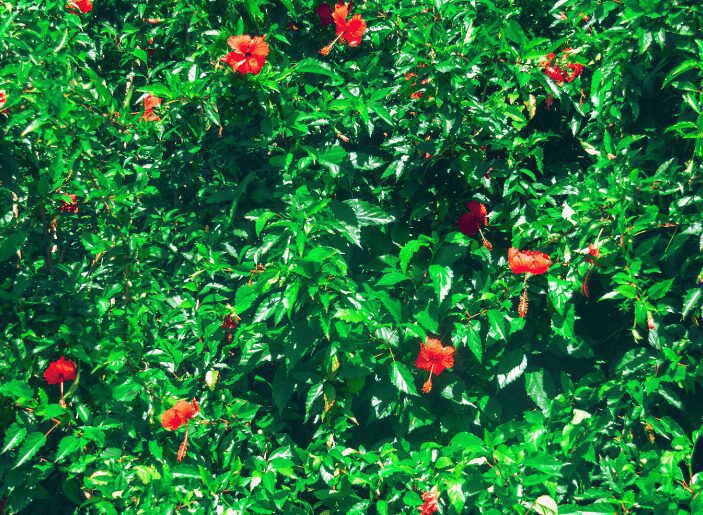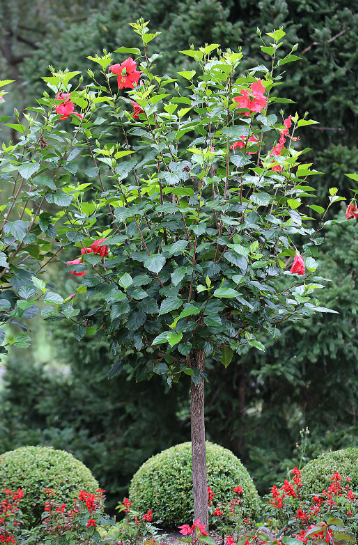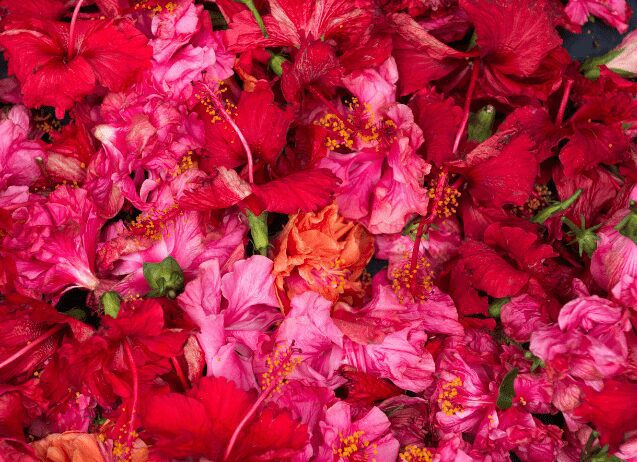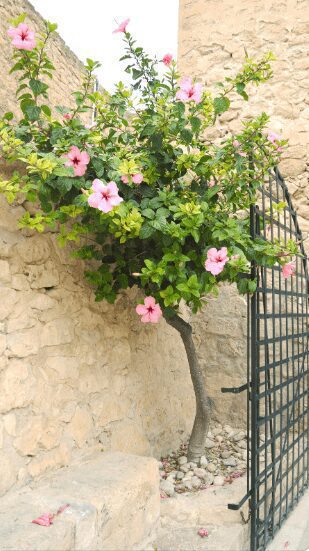
Hibiscus trees make stunning houseplants and can be grown in gardens and indoors in two types: tropical hibiscus (that grows well in warmer regions and look stunning indoors) and winter hardy (Rose of Sharon) for areas where the weather is cold. Rose of Sharon likes well-draining soil alkaline type.
How big do hibiscus shrubs get? Hibiscus shrubs vary in size based on hibiscus species! Compact versions, like Summer Carnival or Plum Flambe™, tend to stay low to the ground, growing to just two or three feet.
These plants are part of the Malvaceae family and grow in full sunlight. The hibiscus tree blooms best during the long season in USDA hardiness zones 5-11.
Hibiscus Tree Information
A Hibiscus flowering tree makes a great houseplant addition because of its striking trumpet-shaped flowers. Summer gardens also benefit from them.
Hibiscus species and cultivars include trees, shrubs, perennials, and annuals, making them the most versatile plants.
Consequently, the Hibiscus flowering tree requires different growth conditions according to its climate.
Hibiscus blooms are available in a rainbow of colors (white, yellow, pink, red, orange, purple, and maroon).
Ornamental Features of Hibiscus Trees
Large and showy flowers are the reason why hibiscus plants are grown. Since these shrubs have breathtaking blooms and attract the attention of humans, their presence gives a vivid picture of a tropical paradise.
Hummingbirds, bees, and butterflies are also attracted to red hibiscus flowers.

The blooming season of these flowering plants lasts all year long in the south or from spring to summer in the north.
These exotic blooms have a one-day lifespan and are transient. The hibiscus plant flower will close up and fall off once it has bloomed.
The hibiscus tree’s foliage is equally impressive. Although they have a fashionable aspect, the huge, colorful flowers that are prominent from mid to late summer make them less noticeable.
While the dwarf hibiscus plant varieties are only three feet tall and can be kept as potted indoor plants, these decorative plants mature at eight feet.
Using Hibiscus Trees for Landscape and Other Purposes
Because they produce huge, vibrant flowers all summer long, hibiscus trees lend a special touch to summer gardens, outdoor settings, and inside spaces.
Their abundant blossoms draw hummingbirds and useful creatures like bees and butterflies. They work best for planting in cities and as foundations (taller hibiscus cultivars).
The spring flowering dwarf hibiscus cultivars can be utilized as hedges, container plants, garden beds, and other butterfly-attracting ornamentals.
The most adaptable plants are hibiscus since hybrids can be trained to grow as bonsai, larger trees, and border shrubs.
The hibiscus tree is valued for its decorative qualities and therapeutic and cultural uses. Its flower tea alleviates various ailments, including decreasing cholesterol, blood pressure, and stomach problems.

The best way to grow hibiscus trees
The evergreen hibiscus flowers bloom all year long in tropical regions (south Florida), although they thrive best in the USDA hardiness zones 5 to 11. They give gorgeous hues to garden beds from late spring through fall. Their one- to two-day flowers draw beneficial insects and backyard birds.
For producing healthy flowers, hibiscus plants prefer full sun to partial shade environments. Furthermore, active growth is also influenced by soil moisture and organic matter.
During the growing season, the hibiscus plants require continuous watering to produce many flowers.
Hibiscus Tree Growing Locations
Large, vibrant flowers on perennial and tropical hibiscus trees can be seen from late spring to fall and throughout the year.
In the USDA hardiness zones 10 to 12, tropical hibiscus trees can withstand the winters and grow in full sunlight.

They produce dark green leaves with stunning single and double flowers in various colors, such as pink, lavender, deep red, white, and orange.
The tropic hibiscus blooms for a significant amount of time virtually all year long in South Florida; however, in North Florida, they will freeze to the ground and blossom again in the spring (grow them in containers as houseplants).
The USDA Hardiness Zones 4 to 9 are suitable for perennial hibiscus trees with big blooms and light-green leaves.
These hibiscus plants require wet, well-draining soil and bloom from mid to late summer.
From Seed to Tree: Growing Hibiscus
Hibiscus seeds require more attention and care than cuttings for propagation. The results, however, are more satisfying, with vibrant blooms in the first growing season.
To begin growing hibiscus at home, start with a hibiscus seedling or an existing hibiscus tree. Keep the hibiscus in bright sunlight and well-drained soil with a pH of 6-7.
Water the hibiscus tree once a day during the hottest months to moisten the soil. Pruning provides the best shape and growth of blooms while encouraging larger plants.
For maximum flowering during the summer months, fertilize every four to six weeks with a balanced solution. With a dedication to care and patience for growth, hibiscus can become an exquisite outdoor feature all year round.
When & How to Plant Hibiscus Tree
Hibiscus Tree Transplanting
- Dig a hole two times wider and deeper than the hibiscus root system in a sunny spot in your garden.
- Once the plant has been removed from its container, please place it in the hole. The root ball should be filled with soil and organic mix (for extra nutrients). With your hands, gently press the ground around the base.
- Water carefully after planting; this will boost hibiscus growth.

Choosing Companion Plants for Hibiscus Trees
Combine the hibiscus tree, a long-season blooming, with warmer-climate native plants that have the same height needs as hibiscus plants.
The best landscape and groundcover plants for hibiscus include Daylily, Bigleaf hydrangea, Crapemyrtle shrub, Japanese anemone, Bee Balm, Caladium, and Sweet Alyssum.
How to Care for Hibiscus Tree?
The full light, rich, moist, and well-draining soils are ideal for the hibiscus tree’s growth and blooming.
In warmer places, tropical hibiscus trees are raised as perennials, whereas in colder climes, they are grown as potted indoor plants.
To bloom, all Hibiscus require six to eight hours of direct sunlight. A guide to cultivating and caring for a healthy plant is provided here;
Water
Regular watering is necessary for hibiscus trees to produce a lot of blooms and thrive. For them to grow and bloom, water them weekly during the growing season.
You won’t need to water your Hibiscus tree very often if your area experiences many rainy spells.
Be aware that hotter Hardiness zones, such as zone 10 and zone 11, require extra caution because of the summer’s intense heat.
Light
Put your hibiscus tree anywhere from the full sun (the sunlight of six hours is excellent) in warmer, subtropical zones like zone 10 and 11 to partial shade (the sunlight of six hours is appropriate) in cooler, gentler zones like zones 5 to 9.
Your hibiscus needs sunlight to bloom vigorously. These plants thrive and produce the greatest blooms when placed in the garden’s sunnier area.
In situations with total shadow, these plants won’t flower.
Your hibiscus tree shedding leaves and yellowing leaves may indicate a shortage of sunshine.

Temperature and Humidity
In USDA zones 9 to 11, tropical hibiscus plants can survive the winter.
The tropical Hibiscus will succumb to frigid climates below this temperature; they thrive at temperatures between 60 and 90 degrees Fahrenheit and can withstand winter temperatures as low as 20 °F.
Hardy Hibiscus trees that can withstand colder climates, such as zone 5-9 with a minimum temperature of -20 degrees Fahrenheit, can live.
Hibiscus Trees Overwinter
In colder climates, the tropical hibiscus tree needs winter care. Bring the containers inside, trim the stem by approximately a third of an inch, and cover them with a thick cloth.
Place the pot in a warmer indoor location with indirect light to induce the dormant condition.
Bring the containers outside and give them excellent development conditions to begin new growths after the threat of freezing temperatures and frost has passed.
Hardy Most winters down to zone 5 are not too harsh for hibiscus to endure. There is no need to mulch the stems of hibiscus during the cooler months because they will die back each winter in these zones.

Best Soil for Hibiscus Tree
In colder climates, the tropical hibiscus tree needs winter care. Bring the containers inside, trim the stem by approximately a third of an inch, and cover them with a thick cloth.
Place the pot in a warmer indoor location with indirect light to induce the dormant condition.
Bring the containers outside and give them excellent development conditions to begin new growths after the threat of freezing temperatures and frost has passed.
Hardy Most winters down to zone 5 are not too harsh for hibiscus to endure. There is no need to mulch the stems of hibiscus during the cooler months because they will die back each winter in these zones.
The fertilizer
Because they produce blooms for a long season, hibiscus trees require routine fertilizer sprays.
Hibiscus vibrant and healthy flowers prefer fertilizers that are strong in potassium and nitrogen while low in phosphorus to promote the development of new growths.
You can always use a balanced fertilizer (10-10-10), but a fertilizer with a 17-5-24 or 12-4-8 NPK ratio for more frequent feeds will also work.
Apply organic fertilizer in early spring to help young foliage and combat pests.
Yellowing Leaves If you’ve noticed the leaves on your hibiscus tree have turned yellow in some areas, it is a sign your plant may need additional micronutrients, such as magnesium or iron.
Maintenance and Pruning
Other hibiscus cultivars do not require much care, while the hardy perennials require frequent trimming and upkeep to produce a greater bloom.
Pruning hardy perennials’ old, broken leaves, branches, and spent blooms will promote new development and give them a clean appearance. It will also increase air circulation.
Hardwood cuttings can be used to propagate hibiscus trees
The hibiscus tree is simple to grow using a variety of techniques. Cutting hardwood is one such technique.
The mature and dormant branch of the perennial shrub, which should be 4 to 30 inches long, should be separated in late fall to early spring to propagate the hibiscus tree using hardwood cuttings.
A rooting hormone solution should be applied to the hardwood cutting.
Ensure the cutting is placed in a potting mix that drains well and give it regular watering.
It will take two months to establish a robust root system and nine months to bloom.
How to propagate a hibiscus tree by grafting
Grafting is one of the finest ways to multiply hibiscus trees. It is a faster and more efficient method for creating new hibiscus plant kinds with robust root systems.
Choose a healthy rootstock from a hardy perennial and a three-inch-long scion or stem cutting from another cultivar to propagate by grafting.
Ensure that the thickness of the rootstock and scion is the same.
Then, grafting tape the union securely around the cambium-on-cambium union of the two cuttings (rootstock and scion).
To maintain high humidity, place a plastic bag over the grafted Hibiscus for two weeks.
Remove any eyes or buds on the rootstock once the new growths emerge on the scion.
Hibiscus Trees Can Be Propagated By Layering
Choose a strong, mature branch from the mother plant to layer-produce hibiscus plants.
Remove the bark between the two cuts on the selected branch, exposing the cambium and white core. The cuts should be spaced approximately an inch apart.
Apply the rooting hormone with a paintbrush to the exposed area of the branch. The bare section of the branch should be covered with damp sphagnum moss, aluminum foil, and a plastic bag to keep it in place.
Within four weeks, it will produce new roots, cut them off from the mother plant below the rootball, and put them in a pot or garden soil.
The most common problems with hibiscus trees
Because of their funnel-shaped flowers, they are planted as annuals, perennials, and evergreen shrubs or trees worldwide.
The Hibiscus is vulnerable to numerous microbiological illnesses and insect pest attacks in unfavorable growing conditions.
Rotting of the roots
Due to inadequate aeration and overwatering, this disease develops. It is brought on by water molds or Phytophthora spp.
These species render the aboveground foliage yellow and brown while making the entire plant look dry and wilted because they feed on the underground root system.
To prevent hibiscus root rot, avoid overwatering the container plants and maintain them in full sun.
Always use containers with ample drainage holes so extra water can be readily drained.
Fungal Leaf Spot
The hibiscus tree’s leaves acquire fungal leaf spots, which are unsightly, black, and uneven blotches that are encouraged by the soil’s moisture.
As the infection continues, these dots coalesce and cover the full surface of the plant leaf.
Unfortunately, other than preventive measures, there is no treatment for these fungus illnesses.
Cut off and remove the infected leaves, and keep the area around the indoor hibiscus tree tidy and clean.
Gray mold (Botrytis blight)
The hibiscus tree develops a botrytis cinerea infection in warm and humid weather.
The gray mold pathogen can infect all plant parts, including foliage, stem, flower buds, and branches. Affected plants exhibit discolored leaves and malformed flower buds.
Pruning off the diseased foliage and buds and properly discarding them will stop the infection from spreading to healthy plants.
Neem oil spray should be used to prevent spore germination and fungal growth.
The most common pests of hibiscus trees
Insect pests can also infest the hibiscus tree, just like microbial diseases.
Aphids
Aphids are minuscule, soft-bodied insects that extract nutrients from plant tissues through their piercing mouthparts.
Their feeding causes the juvenile leaves to fall off too soon, turning the hibiscus foliage yellow and brown.
Their small numbers increase into heavy populations when it is warm and humid, which harms the host plants.
Spray horticultural oil and soapy water on the aphid bodies to suffocate and kill them.
Whiteflies
These insects are cousins of aphids and have the same feeding manner. Whiteflies are considered more harmful to the hibiscus tree because they transmit deadly plant viruses.
Therefore, to avoid severe disease damage, early detection is critical. Introduce the natural enemies of whiteflies, such as lady beetle and green lacewings, to control them.
Spider Mites
These are the tiniest pests that infest or hide on the underside of leaves. Spider mites suck the plant juices out from their foliage and cause a mottled appearance. When in heavy numbers, spider mites can kill young seedlings.
Spray the infested plants with neem oil and insecticidal soap to deter the mite populations, their eggs, and nymphs.
How to spot a spider mite infestation on my Hibiscus tree?
Mite infestations are easy to spot because these tiny creatures develop small pale yellow dots on infested plant leaves and fine webbing on the bottom side of plants.
FAQs on Hibiscus Trees
Does the Hibiscus tree spread quickly?
Different types of hibiscus trees have somewhat vary in their growth rate. For example, the Rose Mallow is a fast-growing hibiscus, while the Chinese rose spreads moderately.
Does the Hibiscus tree come back every year? Is it annual or perennial?
The perennial and hardy hibiscus varieties come back yearly and add vibrant summer colors to gardens.
On the other hand, the tropical Hibiscus does not come back because it can not tolerate the harsh winters and best thrives as an annual indoor plant.
How far apart do you plant the Hibiscus tree?
When growing Hibiscus in the garden, plant them at a distance of 2 to 3 feet apart.
When should the Hibiscus tree be planted?
The hibiscus tree should be planted in spring, so the plants will have an entire growing season to develop a robust root system and fight back against pest invasions.
Is the Hibiscus tree toxic to dogs?
Most hibiscus varieties are non-toxic to dogs, but the Rose of Sharon flower causes nausea and vomiting upon ingestion.






















